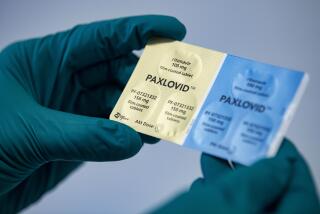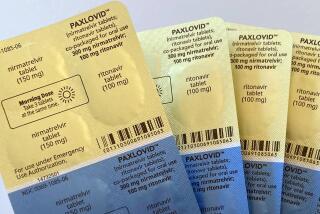AIDS Victims Wasting Away Despite Drug, Study Finds
- Share via
NEW YORK — Many of the first AIDS patients treated with the much-heralded medication AZT appear to be wasting away during their second year on the drug, and their doctors are now pessimistic about their chances for continued survival, it was reported here Monday.
Doctors from the University of Miami School of Medicine said patients on long-term AZT (azidothymidine) are losing the weight they gained during the first months of therapy and are developing the life-threatening infections that seemed to have been forestalled by the drug.
For the record:
12:00 a.m. Oct. 17, 1987 For the Record
Los Angeles Times Saturday October 17, 1987 Home Edition Part 1 Page 2 Column 1 Metro Desk 3 inches; 85 words Type of Material: Correction
An Oct. 6 article in The Times reported that many of the first AIDS patients to receive the drug AZT at the University of Miami were wasting away from severe weight loss during their second year of therapy. The researcher on whose work the article was based now says he “misinformed” The Times about the weight loss results. Dr. Gordon Dickinson said in a telephone interview that the patients had only lost the weight they initially gained after AZT treatments began and that their weight later stabilized. Dickinson said he discovered the error after receiving news media inquiries prompted by The Times article.
“AZT appears to be a palliative form of treatment that prolongs life and reduces suffering but . . . once you get out beyond 18 months, you see deterioration,” said Dr. Gordon Dickinson, one of the Miami researchers.
He presented the study at the Interscience Conference on Antimicrobial Agents and Chemotherapy, a meeting on infectious diseases with about 10,000 participants.
Affects 16,000 People
The data is potentially significant for the estimated 16,000 people with AIDS or AIDS-related complex who are now receiving AZT, the only anti-AIDS medication approved for marketing in the United States. The majority started treatment within the last year.
The ongoing Miami study involves 60 patients with AIDS or AIDS-related complex who have been treated with AZT for more than six months, Dickinson said. Fifty patients have received the medication for more than a year and 21 have been treated for longer than 17 months. Three patients have died. By comparison, it is estimated that about half the patients would have died within one year if they had not been treated with AZT.
In the first six months of therapy, the Miami patients gained an average of 22 pounds and produced larger numbers of infection-fighting “T-4” white blood cells.
But over the next six months, the patients lost the weight and the T-4 cells they had gained, and many developed serious infections.
After 14 months of treatment, patients had lost an average of 22 pounds, compared to their weight when they first started the medication and disease progression was evident.
Another problem is that only 30% of the Miami patients have been able to continue taking full doses of AZT. The others have had their doses reduced or therapy interrupted, primarily because they developed severe anemias.
The U.S. Food and Drug Administration approved prescription sales of AZT in March after encouraging results with the drug were reported in patients with the AIDS-related form of pneumonia called Pneumocystis carinii .
Many physicians hope that AZT will stabilize these patients until more effective AIDS treatments can be developed, a process that could take many years. The drug is also being tested in patients with dozens of other AIDS-related illnesses.
Another somber note was struck by Dr. Ann Hardy of the federal Centers for Disease Control, who reported that the survival rate for AIDS patients is apparently much worse than official figures suggest, with between 95% and 98% of patients dying within three years of diagnosis.
Hardy had set out to find out why some people with AIDS survive much longer than others. Instead, she found that many of the 15% of AIDS patients who were reported to have survived for more than three years were in fact dead.
Most of the small number of survivors have the AIDS-related tumor, Kaposi’s sarcoma, Hardy said. In other survivors, her study raised doubts about the accuracy of the initial AIDS diagnoses.
Hardy’s pessimism was shared by Dr. Richard Chaisson of San Francisco General Hospital, who reported on the survival of the 505 San Francisco AIDS patients who were diagnosed before July, 1984.
About 11% of the San Francisco patients, all with Kaposi’s sarcoma, were alive after three years. But Chaisson found that the average survival of such patients had decreased from 27 months for those diagnosed before June, 1983, to 11 months for those diagnosed later. The more recently diagnosed tumor patients appear to have sustained more damage to their immune systems.
More to Read
Sign up for Essential California
The most important California stories and recommendations in your inbox every morning.
You may occasionally receive promotional content from the Los Angeles Times.










